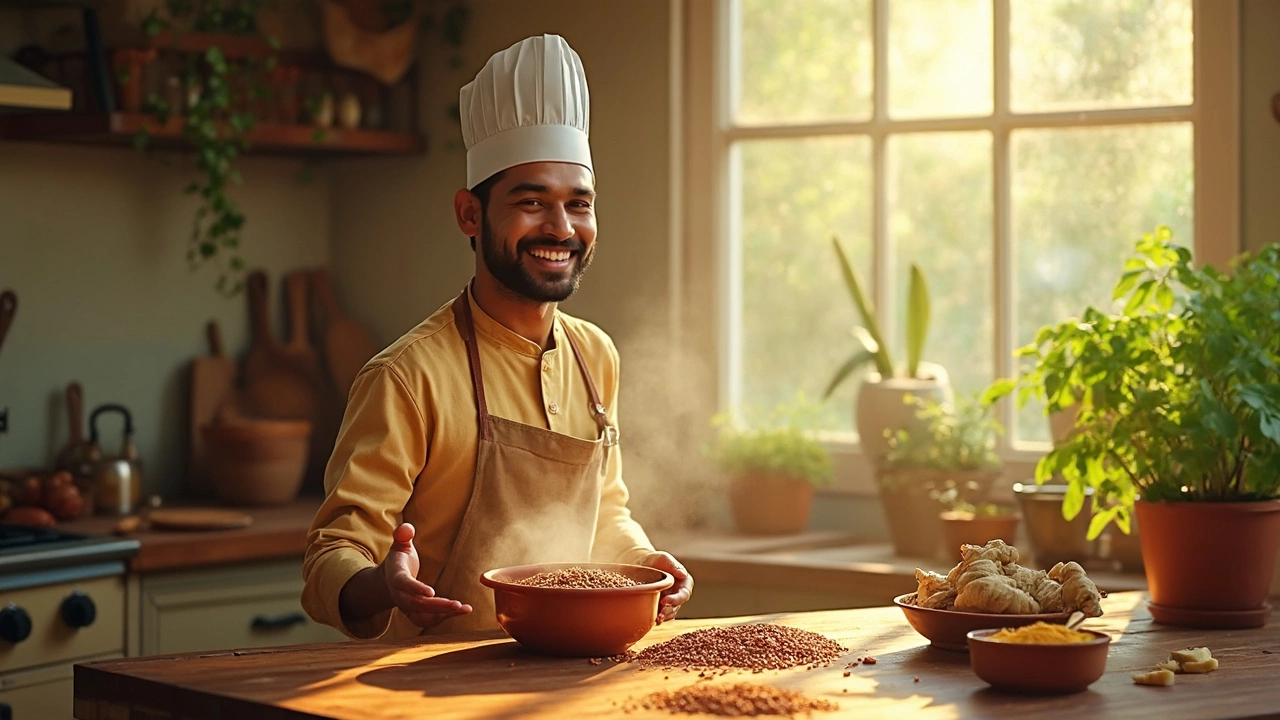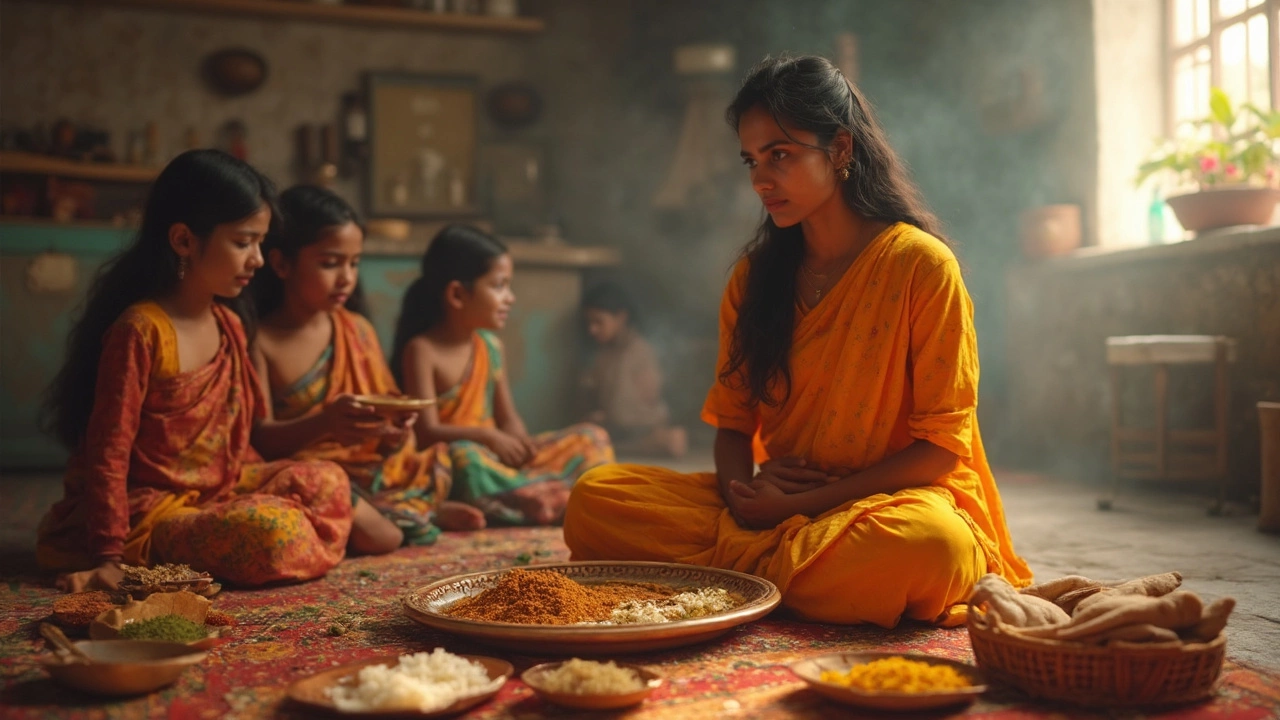You just devoured a comforting bowl of dal and now your stomach feels like a balloon. Happens to a lot of us, honestly. But why does this super healthy comfort food sometimes make us uncomfortable?
The short answer is, dal (lentils) has certain ingredients that your gut bacteria love to throw a party with, creating gas as a not-so-lovely side effect. It's not just your imagination—science really does back this up. Lentils are packed with complex carbs and fiber, which don’t always get fully digested until they hit your colon. When the bacteria get to work breaking them down, you end up with gas.
You don’t have to give up dal altogether though. There are a bunch of easy ways to make it easier on your belly, from soaking your lentils longer to adding the right spices. Curious which tip works best? Stick around. This guide is packed with practical ideas that actually work in Indian kitchens.
- What's Really in Dal?
- How Dal Causes Gas
- Smart Cooking Tips to Avoid Bloating
- Dal Varieties That Are Gentler on Your Stomach
- Your Go-To Dal Recipes for Better Digestion
What's Really in Dal?
Let’s break it down: dal is basically split pulses or lentils, and they’re little powerhouses of nutrition. A typical serving packs in a mix of protein, complex carbs, and a surprising amount of fiber. If you’re vegetarian or just looking to get more plant protein, dal is a total staple—it’s got about 9 grams of protein per cooked cup.
But here’s the kicker. The carbs in dal are not all simple or quick to digest. There’s something called resistant starch and certain sugars known as oligosaccharides. These are pretty tough for your small intestine to process. So, they pass through and land in the large intestine, where bacteria break them down, sometimes giving you that gassy, bloated feeling.
Fiber is great for your gut, but it also adds to the gas game, especially if you're not used to eating a lot of it. Don’t forget: dal has a solid amount of iron, potassium, and B vitamins, too. But the reason you’re sometimes left feeling uncomfortable isn’t the nutrients themselves—it's how your body reacts to all the starch and natural sugars inside.
Different types of dal have slightly different makeups. For example, moong dal is usually gentler on the stomach compared to chana dal or rajma (kidney beans, which are technically not dal but have the same effect). If you want to enjoy gassy after dal less often, knowing what’s actually in your bowl is a strong first step.
How Dal Causes Gas
So, why exactly do you end up feeling so gassy after dal? Simple answer: it’s the way your gut deals with lentils. Dal is full of fibers called raffinose and resistant starch. These give dal its nutrition punch, but human stomachs can’t fully break them down on their own. When these fibers reach your large intestine, gut bacteria start munching on them—creating gas as a byproduct.
It’s also not just one kind of gas. The process makes a mix of hydrogen, methane, and carbon dioxide, which build up and leave you bloated. Everybody’s system is a bit different, so some folks feel more gassy than others. If you eat dal often, your gut can sometimes get used to it and calm down a bit over time, but not always.
Another big factor is how you cook your dal. Undercooked lentils are way harder for the body to handle. Skipping proper soaking or cooking also means more of those tough fibers get through, causing extra trouble in your intestines.
- Eating dal quickly, without chewing well, can add extra air and make the bloating worse.
- Some dal recipes add extra veggies like cauliflower, onion, or cabbage, which are gassy on their own. Combo effect!
- If you suddenly start eating more lentils than usual, your body will take time to adapt to the fiber load.
The gassy after dal feeling may be annoying, but it’s a sign your gut bacteria are doing their job. The good news? There are easy tricks to keep gassiness in check. Just soak, cook well, and don’t overload your plate with fiber in one meal.

Smart Cooking Tips to Avoid Bloating
If you love dal but hate feeling gassy after, you’re not stuck. You can change a few things about how you cook your dal and notice a real difference. Let’s get into the everyday stuff you can do in your kitchen so your tummy doesn’t fight back after a tasty meal.
- Soak longer, cook better: Don’t just rinse and go. Soak your dal at least 4-6 hours, or leave it overnight. This breaks down some of those hard-to-digest sugars, making it much easier on your gut.
- Always rinse well: Give your dals a good wash before soaking. It really helps remove dust and some of the oligosaccharides—the real culprits behind the gas.
- Use the right spices: Mother-in-law hacks work. Add ginger, cumin seeds, asafetida (hing), and turmeric to your dal. These help break down starches and calm your digestive system. Hing in particular is famous in Indian kitchens for reducing bloating.
- Pressure cook is king: Pressure cooking isn’t just about speed. It softens dal more thoroughly than boiling, making the protein and carbs easier to break down.
- Skim off the foam: You’ll see froth at the top or bubbles while your dal is boiling. Skim it off with a spoon—this foam holds some of the stuff that makes you gassy.
Here’s a quick look at how cooking methods measure up when it comes to ease of digestion:
| Cooking Method | Gas-Causing Potential | Ease of Digestion |
|---|---|---|
| Soaking & Pressure Cooking | Low | Best |
| Boiling Without Soaking | High | Poor |
| Adding Hing & Spices | Lower | Better |
The most important trick? Consistency. If you make soaking, rinsing, and spicing a habit, you really can reduce the feeling of being gassy after dal. And if one trick isn’t enough, combine them for best results. Your gut will thank you.
Dal Varieties That Are Gentler on Your Stomach
Not all dals are created equal when it comes to causing gas. If your stomach throws a fit after eating chana dal or rajma, you’re not alone. Some dal types are way easier on your belly than others, and thankfully, they’re super common in Indian kitchens.
Here’s the breakdown of which dals are usually easier to digest:
- Moong dal: This is your safest bet. It’s mild, cooks quickly, and people rarely complain about gas after eating it. Split yellow moong is the gentlest form, while whole green moong is a close second.
- Masoor dal (red lentils): These guys are soft and light, perfect if you don’t want to feel bloated post-lunch. They break down quickly during cooking and in your stomach.
- Toor dal (arhar): Not as easy as moong, but still gentler than some of the bigger dals. As long as you don’t eat heaps, your gut should be fine.
On the other side, dals like chana dal, urad dal (think dal makhani), and whole black gram tend to be heavy-duty for your digestion. They take longer to break down and make your gut bacteria throw a bigger, gassier party.
Check out this quick chart for reference:
| Dal Type | Gas-causing Level | Cooking Time (mins) |
|---|---|---|
| Moong Dal (Yellow Split) | Low | 15-20 |
| Masoor Dal (Red Lentils) | Low | 15-20 |
| Toor Dal | Moderate | 30-40 |
| Urad Dal | High | 40-60 |
| Chana Dal | High | 35-45 |
If you’re especially sensitive, stick with gassy after dal solutions like using yellow moong or masoor dal in your recipes. Less cooking time, less bloating—it’s a win-win. And if you’re craving that rich dal makhani, try making it with split moong sometimes. Your stomach will thank you.

Your Go-To Dal Recipes for Better Digestion
Making dal so it’s gentle on your stomach isn’t rocket science. The key is choosing the right kind, prepping it the right way, and throwing in some smart tweaks. When you do that, you get all the comfort and nutrition of dal, minus the gas and bloat.
Here’s a simple rule: gassy after dal isn’t just about the lentils. It’s about how you cook and eat it. Take arhar (toor) dal and moong dal—these are much lighter compared to rajma or chana dal. Split and hulled dals are easier to digest than whole ones. A research paper from 2020 published by the National Institute of Nutrition revealed that people who ate moong dal reported 30% less bloating compared to those who had whole urad dal.
Here are some pro tips to make your next bowl of dal a breeze for your belly:
- Soak your dal: At least 6-8 hours for most lentils. This cuts down the hard-to-digest stuff and slashes cooking time.
- Rinse before cooking: Fresh water after soaking gets rid of the starches and some of the sugars that cause gas.
- Add gut-friendly spices: Cumin (jeera), asafoetida (hing), ginger, and turmeric help your stomach do its job better. Asafoetida is a game changer—just a pinch in your tadka can work wonders.
- Don’t overload on onion and garlic: They also ramp up gas in some people. Adjust or skip as per your gut’s reaction.
- Try pressure cooking: It breaks down dal making it easier for your gut.
- Eat with rice: Dal-rice is not just classic, it balances amino acids and rice helps buffer your digestion.
Alright, want to try some recipes that go easy on the belly? Here are two you should have on repeat:
- Simple Moong Dal: Pressure cook soaked yellow moong with turmeric and salt, do a tadka with jeera, hing and ginger, and top with a squeeze of lemon. Super light and quick!
- Toor Dal with Spinach: Mix soaked toor dal with spinach, turmeric, and a touch of ginger for extra fiber and iron. Use minimal oil in the tadka, and add hing generously.
If you like numbers, check this out:
| Dal Type | Soaking Time | Reported Gas Issues (per 100 people) |
|---|---|---|
| Moong Dal (Split & Husked) | 6 hours | 22 |
| Toor Dal (Split) | 8 hours | 28 |
| Urad Dal (Whole) | 10 hours | 41 |
Notice how the more processed (split and husked) dals are much milder on your stomach?
As Dr. Rajesh Shah, a well-known gastroenterologist, says: “Soaking and using gut-friendly spices like cumin and asafoetida can cut down on lentil-induced bloating by half in most patients.”
Bottom line—tweak your dal routine just a bit and you can keep both your tastebuds and tummy happy.
